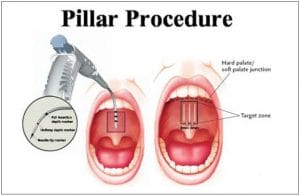
The pillar procedure is a minor surgical procedure in which small reinforcing rods are inserted into the soft palate under local anaesthetic. The rods are intended to reinforce the soft palate, preventing it from collapsing and blocking the airways during sleep and thereby treating snoring and sleep apnea.

At its initial introduction it was widely popular, but over time the popularity of this procedure has waned and few doctors recommend it any more. The procedure is considered controversial since it has a relatively low success rate.
Some subjects complain of discomfort and the ability to ‘feel’ the reinforcing through the skin of the soft palate after the procedure. However, many snorers are so eager to overcome their sleep problems, that they take the plunge anyway in the hopes that the procedure will prove effective in their situation.
This procedure, however should be a last resort, and other methods of reducing or preventing snoring should be tried before resorting to surgery. The major arguments against the pillar procedure can be summed up as:
- Not always effective
- Invasive (involves surgery)
- Pillar procedure cost
Pillar procedure cost is seen as the primary reason why very few people resort to this form of treatment. Reports on pillar procedure cost vary, with sources mentioning pricing of up to $4000 for the procedure.
Since the procedure is not covered by most medical insurances, the patient has to foot the entire bill. One of the reasons why this procedure is so expensive is that it uses proprietary technology or ‘intellectual property’.
That means that your doctor has to purchase the plastic rods from a specific supplier – and you may be certain that they do not come at a particularly reasonable price.
Before you choose the pillar procedure:
There are a variety of effective anti-snoring devices that you can try in order to treat snoring and sleep apnea. All of these come at a much lower cost than the pillar procedure and none of them involve any form of surgery.
However, not all of these devices are equally effective. Although it is to be expected that results may vary from person to person, certain devices seem to deliver better results and get better reviews overall. Reading our Comparison Table may help you investigate alternatives.
